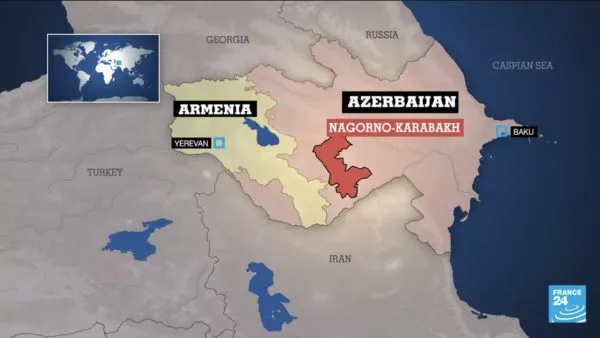Using Armenia to Destroy the International North South Transportation Corridor
TRANSCEND MEMBERS, 9 Oct 2023
Matthew Ehret Insights – TRANSCEND Media Service
The recent dissolution of Nagorno Karabakh and the Armenia embrace of a US-led world order represent something much larger than either small country and have everything to do with destabilizing the largest, and arguably most strategic, mega-project in Eurasia connecting the Russian Arctic to Iran and India.
4 Oct 2023 – Efforts to light geopolitical fires across Russia’s underbelly have been relentless in recent years (with a failed color revolution in Kazakhstan in January 2022, a renewed color revolution effort in Georgia in March of this year, clashes between neighboring Kyrgyzstan-Tajikistan in 2022, ongoing threats of color revolution in Serbia, threats to blow up Transnistria in Moldova, and the obvious fire in Ukraine).
Amidst all of these arson attempts, one thing is certain, the technocrats managing the collapsing western death cult are obsessed with kicking over the chess board using every dirty trick in the book.
Introducing The International North South Transportation Corridor
Until recently, the primary trade route for goods passing from India to Europe has been the maritime shipping corridor passing through the Bab El-Mandeb Strait linking the Gulf of Aden to the Red Sea, via the highly bottlenecked Suez Canal, through the Mediterranean and onward to Europe via ports and rail/road corridors.
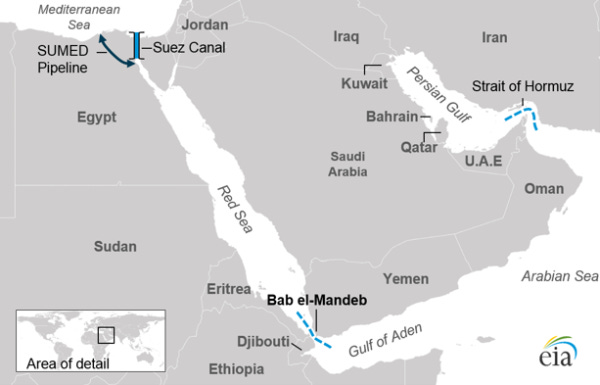
Following this western-dominated route, average transit times take about 40 days to reach ports of Northern Europe or Russia. Geopolitical realities of the western technocratic obsession with global governance have made this NATO-controlled route more than a little unreliable.
On top of that, Russia remains one of the most important global suppliers of oil, natural gas, fertilizers and grain – but with the NATO/EU clown show increasingly sabotaging access to Russian goods, new connections are desperately needed to avoid plunging the world into a chain reaction collapse.
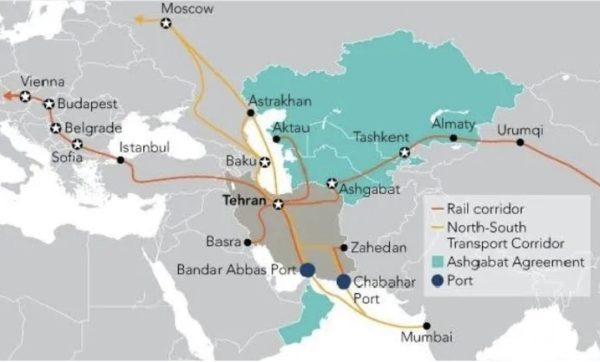
Despite being far from complete, goods moving across the International North-South Transportation Corridor (INSTC) from India to Russia have already finished their journey 14 days sooner then their Suez-bound counterparts while also seeing a whopping 30 percent reduction in total shipping costs.
These figures are expected to fall further as the project progresses. Most importantly, the INSTC would also provide a new basis for international win-win cooperation much more in harmony with the spirit of geo-economics unveiled by China’s Belt and Road Initiative (BRI) in 2013.
Doing Business Without Killing Your Customers
Originally agreed upon by Russia, Iran, and India in September 2000, the INSTC only began moving in earnest in 2002 – albeit much more slowly than its architects had hoped.
This 7,200 km multimodal megaproject involves integrating several Eurasian nations directly or indirectly with rail, roads, and shipping corridors into a united and tight-knit web of interdependency. Along each artery, opportunities to build energy projects, mining, and high tech special economic zones (SEZs) will abound giving each participating nation the economic power to lift their people out of poverty, increase their stability and their national power to chart their own destinies.
Beyond the founding three nations, the other 10 states who have signed onto this project over the years include Armenia, Georgia, Turkey, Azerbaijan, Kazakhstan, Belarus, Tajikistan, Kyrgyzstan, Oman, Syria and even Ukraine (although this last member may not remain on board for long). In recent months, India has officially invited Afghanistan and Uzbekistan to join too.
While western think tanks and geopolitical analysts attempt to frame the INSTC as an opponent to China’s BRI, the reality is that both systems are extremely synergistic on multiple levels.
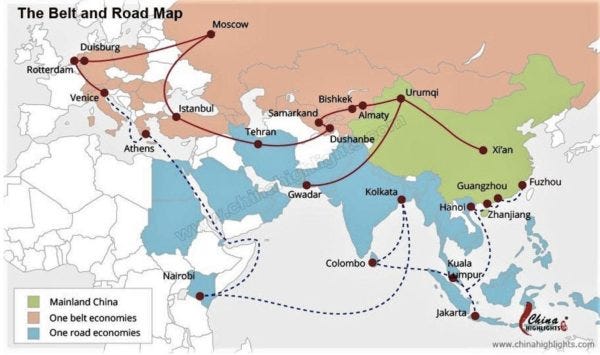
Unlike the West’s speculation-driven bubble economy, both the BRI and INSTC define economic value and self-interest around improving the productivity and living standards of the real economy. While short term thinking predominates in the myopic London-Wall Street paradigm, the BRI and INSTC investment strategies are driven by long-term thinking and mutual self-interest.
It is no small irony that such policies once animated the best traditions of the West before the rot of unipolar thinking took over and the West lost its moral compass.
An Integrated Alternative
The INSTC’s two major bookends are the productive zone of Mumbai, in India’s Southeast region of Gujarat, and the northern-most Arctic port of Lavna in Russia’s Kola Peninsula of Murmansk.
This is not only the first port constructed by Russia in decades, but when completed, will be one of the world’s largest commercial ports with an expected capacity to process 80 million tons of goods by 2030.
The Lavna Port is an integral part of Russia’s Arctic and Far East Development vision and is a central piece to Russia’s current Comprehensive Plan for Modernization and Expansion of Main Infrastructure and its Northern Sea Route which is expected to see a five-fold increase of Arctic freight traffic over the coming years. These projects are integrally linked to China’s Polar Silk Road.
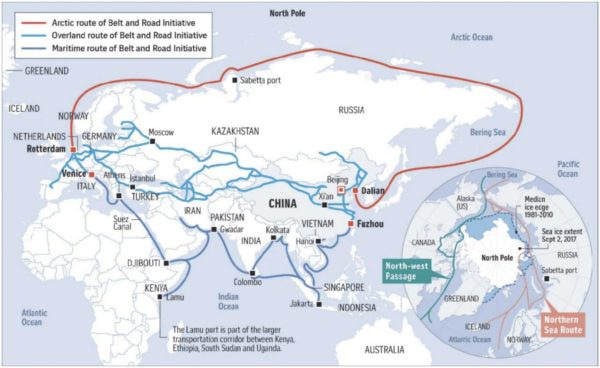
Between these bookends, the INSTC moves freight from India into Iran’s Port of Bandar Abbas where it is loaded onto double-tracked rail to the Iranian city of Bafq and then to Tehran before coming to the Anzali Port on the southern Caspian Sea.
Because the INSTC is based on a flexible design concept capable of adapting to a changing geopolitical environment (very much like the BRI), there are a multitude of connecting lines that branch off the main North-South artery before goods make it to the Caspian Sea.
These include an eastern and western corridor branching off from the city of Bafq towards Turkey and thence Europe via the Bosporus and also eastward from Tehran to Turkmenistan, Uzbekistan, Kazakhstan, and thereafter into Urumqi in China.
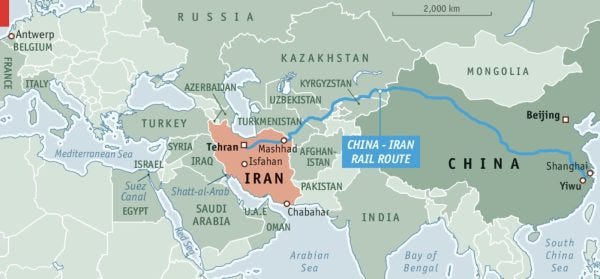
The Strategic Importance Of Railways
From the Anzali Port in the north of Iran, goods may travel by the Caspian Sea towards Russia’s Astrakhan Port where it is then loaded onto trains and trucks for transport to Moscow, St. Petersburg and Murmansk. Inversely, goods may also travel over land to Azerbaijan where the 35 km Iran Rasht-Caspian railway is currently under construction with 11 km completed as of this writing.
Once completed, the line will connect the Port of Anzali with Azerbaijan’s Baku, offering goods a chance to either continue onwards to Russia or westward toward Europe. A Tehran-Baku rail route already exists.
Additionally, Azerbaijan and Iran are currently collaborating on a vast $2 billion rail line connecting the 175 km Qazvin-Rasht railway which began operations in 2019 with a strategic rail line connecting Iran’s Rasht port on the Caspian to the Bandar Abbas Complex in the south (to be completed in 2025). Sergey Pavlov, First Deputy Managing Director of Russian Railways stated in March 2023: “The Ministry of Transport is preparing two intergovernmental agreements: Iran-Russia and trilateral Azerbaijan-Russia-Iran.”
In recent months, India’s Prime Minister Narendra Modi has lobbied to incorporate the joint Iran-India built Chabahar Port into the INSTC which will likely occur since another 628 km rail line from the port to the Iranian city of Zahedan is currently under construction.
Since 2014, a vast rail and transportation complex has grown around the co-signers of the Ashkabat Agreement (launched in 2011 and upgraded several times over the past decade). These rail networks include the 917.5 km Iran-Turkmenistan-Kazakhstan route launched in 2014, and Turkmenistan-Afghanistan-Tajikistan rail/energy project launched in 2016 which is currently seeing extensions that could easily go into Pakistan.
In December 2021, the 6540 km Islamabad to Istanbul rail line (via Iran) recommenced operations after a decade of inaction. This route cuts the conventional sea transit route time of 21 days by half. Discussions are already underway to extend the line from Pakistan into China’s Xinjiang Province linking the INSTC ever more closely into the BRI on yet another front.
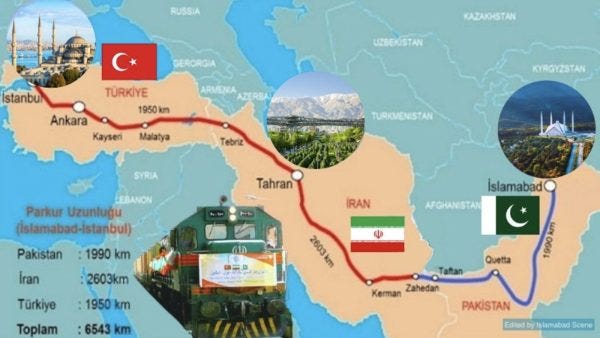
Finally, June 2022 saw the long-awaited unveiling of the 6108 km Kazakhstan-Iran-Turkey rail line which provides an alternative route to the under-developed Middle Corridor. Celebrating the inaugural 12 day voyage of cargo, Kazakhstan’s President Kasym-Jomart Tokayev stated:
“Today, we welcomed the container train, which left Kazakhstan a week ago. Then it will go to Turkey. This is a significant event, given the difficult geopolitical conditions.”
Under these dynamics the long overdue Southern Armenian Railway could be built providing the missing 316 km link of the North-South Transport Corridor between the Black Sea and Persian Gulf. This project involves an incredible 84 bridges (19.6 km) and 60 tunnels (102.3 km) through the mountainous terrain ultimately connecting the Persian Gulf’s main artery to Europe with vast benefits for all nations and people involved.
The INSTC, BRI, and other great infrastructure projects would not only create new relationships and open up new markets over the course of many years, but would also provide the basis for new industries, increased productive potential and incredible investment potentials for all interests regardless of religious, ethnic, or other differences which imperialists have sought to exploit for eons.
Unfortunately if the Soros puppet president of Armenia Nikol Pashinyan (installed during a color revolution in 2018) is successful at sabotaging the Russian-led Eurasian Economic Union and Russian-led Collective Security Treaty Organisation (CSTO), while embracing NATO, then these prospects for Eurasian integration might go up in flames.
____________________________________________
 Matthew Ehret is a member of the TRANSCEND Network for Peace Development Environment, a journalist, and co-founder of the Rising Tide Foundation. He is the Editor-in-Chief of Canadian Patriot Review, Senior Fellow at the American University of Moscow and host of The Great Game on Rogue News. He has authored the book series The Untold History of Canada and the recently published book series The Clash of the Two Americas. Email: matt.ehret@tutamail.com
Matthew Ehret is a member of the TRANSCEND Network for Peace Development Environment, a journalist, and co-founder of the Rising Tide Foundation. He is the Editor-in-Chief of Canadian Patriot Review, Senior Fellow at the American University of Moscow and host of The Great Game on Rogue News. He has authored the book series The Untold History of Canada and the recently published book series The Clash of the Two Americas. Email: matt.ehret@tutamail.com
Go to Original – matthewehret.substack.com
Tags: Armenia, Azerbaijan, Central Asia, Hegemony, Imperialism, India, Iran, Nagorno-Karabakh, RBIO-Rules Based International Order, Russia, USA
DISCLAIMER: The statements, views and opinions expressed in pieces republished here are solely those of the authors and do not necessarily represent those of TMS. In accordance with title 17 U.S.C. section 107, this material is distributed without profit to those who have expressed a prior interest in receiving the included information for research and educational purposes. TMS has no affiliation whatsoever with the originator of this article nor is TMS endorsed or sponsored by the originator. “GO TO ORIGINAL” links are provided as a convenience to our readers and allow for verification of authenticity. However, as originating pages are often updated by their originating host sites, the versions posted may not match the versions our readers view when clicking the “GO TO ORIGINAL” links. This site contains copyrighted material the use of which has not always been specifically authorized by the copyright owner. We are making such material available in our efforts to advance understanding of environmental, political, human rights, economic, democracy, scientific, and social justice issues, etc. We believe this constitutes a ‘fair use’ of any such copyrighted material as provided for in section 107 of the US Copyright Law. In accordance with Title 17 U.S.C. Section 107, the material on this site is distributed without profit to those who have expressed a prior interest in receiving the included information for research and educational purposes. For more information go to: http://www.law.cornell.edu/uscode/17/107.shtml. If you wish to use copyrighted material from this site for purposes of your own that go beyond ‘fair use’, you must obtain permission from the copyright owner.
